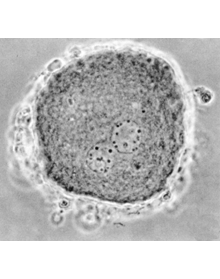The Stages of Human Embryonic Development
Stage 1 embryos have the potential to develop into all of the subsequent stages of a human being. Stage 1 starts at the beginning of fertilization, when an oocyte is penetrated by a sperm, and ends with the intermingling of the paternal (male) and maternal (female) chromosomes on the spindle at metaphase of the first mitotic division of the single cell.
The events of stage 1 require just over 24 hrs. to complete and normally take place in the ampulla of the uterine tube. The embryo is between 0.1 to 0.15 mm in diameter and weighs approximately 0.004 mg.
Stage 1 is divided into three substages; a, b and c. Stage 1a is referred to as the 'primordial embryo' since all the genetic material necessary for the new individual, plus some redundant chromosomes, is now within a single plasmalemma (cell membrane). From the perspective of the female gamete it has also been named the penetrated oocyte. The fertilizing sperm has passed through the zona (capsula) pellucida and its plasmalemma has fused with that of the oocyte. Penetration activates the embryo into resuming its arrested meiosis II and after anaphase it enters telophase with the expulsion of the redundant chromosomes as a second polar body. This marks the beginning of Stage 1b in which the single-cell is referred to as the 'pronuclear embryo'. From the perspective of the female gamete it has also been named the ootid because its female component is haploid like a spermatid, however, in the pronuclear embryo there are two separate haploid components: one maternal pronucleus and one paternal pronucleus. The pronuclei move toward each other and eventually compress their envelops where they lie adjacent near the center of the cell. During Stage 1c the unicellular embryo is called a 'syngamic embryo' or zygote. This is the last phase of fertilization and exists for a relatively short period. The pronuclear envelopes disappear and the parental chromosomes come together in a process called syngamy thereby establishing the genome of the embryo. The chromosomes assume positions on the rapidly forming first mitotic spindle in preparation for cleavage.
For further information about Stage 1 Embryos, including access to the DREM Dataset, click here
